
How to make a garden track from concrete with plastic forms? Plot.

Beautiful paths play an important role in attaching a plot of a certain style and individuality. They are not only convenient and allow you to move on it into any weather without risk to stain shoes, but also can decorate the yard and garden. Make concrete tracks with your own hands is easy, but they will only serve for a long time in the case of correctly performed work.
Content
Construction Materials
There are many options for performing beautiful paths. For a long time, a narrow solid concrete fabric remained in the past. Special plastic forms for garden tracks allow you to create paths, externally similar to sidewalks lined with tiles or stone. The following building materials will be needed to perform work:
- crushed stone;
- sand shallow fraction;
- cement;
- geotextile (Dornit);
- plasticizer;
- dyes;
- polymer forms.
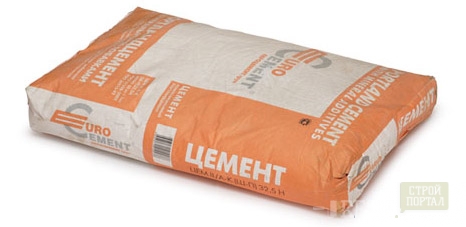
Polymer form
Plastic shape for tracks - stencil, which is filled with concrete. It is made of polypropylene and designed for 1000 fillings. The thickness of the outer walls is 6 mm, internal partitions - 3 mm. Forms differ in configuration and sizes. The thickness of the tile depends on its height - it is usually 50-60 mm. Jumpers may have the same size or be shorter than several centimeters. In this case, at the base of the molding, a one-piece plate is obtained in 2-3 cm, on which the "pebbles" are 3-4 cm thick.
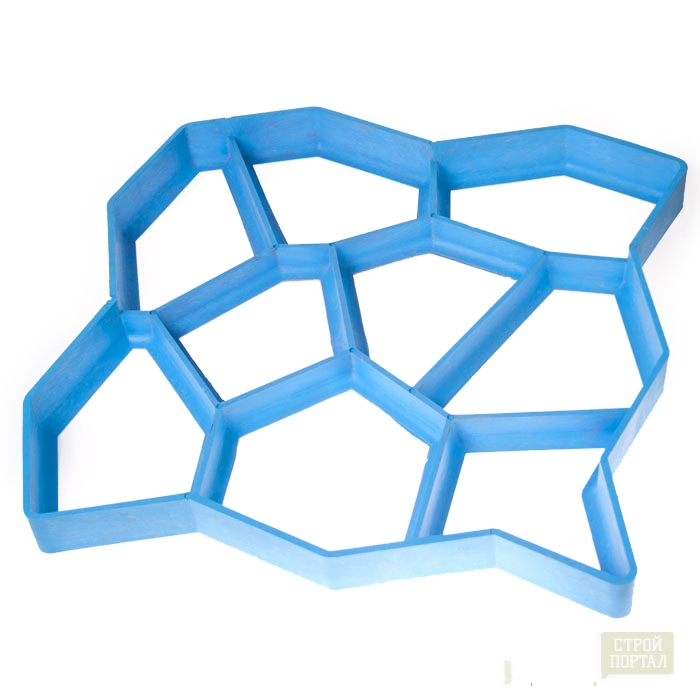
How to make a concrete track - construction sequence
Design
Before starting work, you should decide on the most convenient location of future tracks and their shape. In the classic style, they are performed on flat lines, with a rectangular intersection. By organizing concrete paths at the cottage in a more free, landscaped version can be given by the will of fantasy. These are different bends of paths, rounded shapes and intersections. Developing the scheme of their gaskets, you should consider the habits of people and the convenience of their movement on the site.
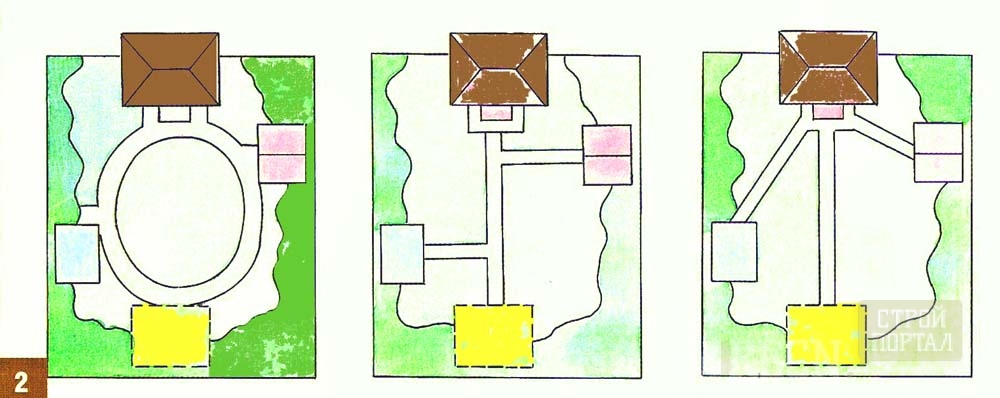
Preparation of the basis
- According to the diagram drawn up the tracks.
- With the help of roulette, cords and pegs are marked their borders.
- Then at least 20 cm is cut into the upper layer of the soil - Derne.
- The bottom of the trench is rambling and falling asleep with a layer of rubble with a thickness of 10-15 cm, which covers geotextile. The material will not exist to the weeds and hurts the sand to go into the ground - the garden concrete path will turn out more durable.

- Geotextile falls asleep with sand with a layer of 4-5 cm and again tamper.
- A 4-centimeter mixture of sand with cement is the last layer in the prepared base, although often this layer is not used. In this case, before the fill of the forms of sand is abundantly water from the sprayer. This is done so that the soil does not pull moisture from concrete. When the base device creates a small slope for precipitation.
Preparation of solution and filling forms
After the substrate for the track is ready, a solution of cement, sand and rubble is mixed in a ratio of 1: 3: 3. Concrete should have a thick, plastic consistency - otherwise it will be spread. Manually, without experience, it is difficult to cook it. The optimal option is the use of concrete mixer. Adding a plasticizer will improve the quality of the solution and increase its frost resistance. It is believed that the plastic form for the concrete path does not require lubrication. But if you use machine oil, it will be easier to get it out of solution.
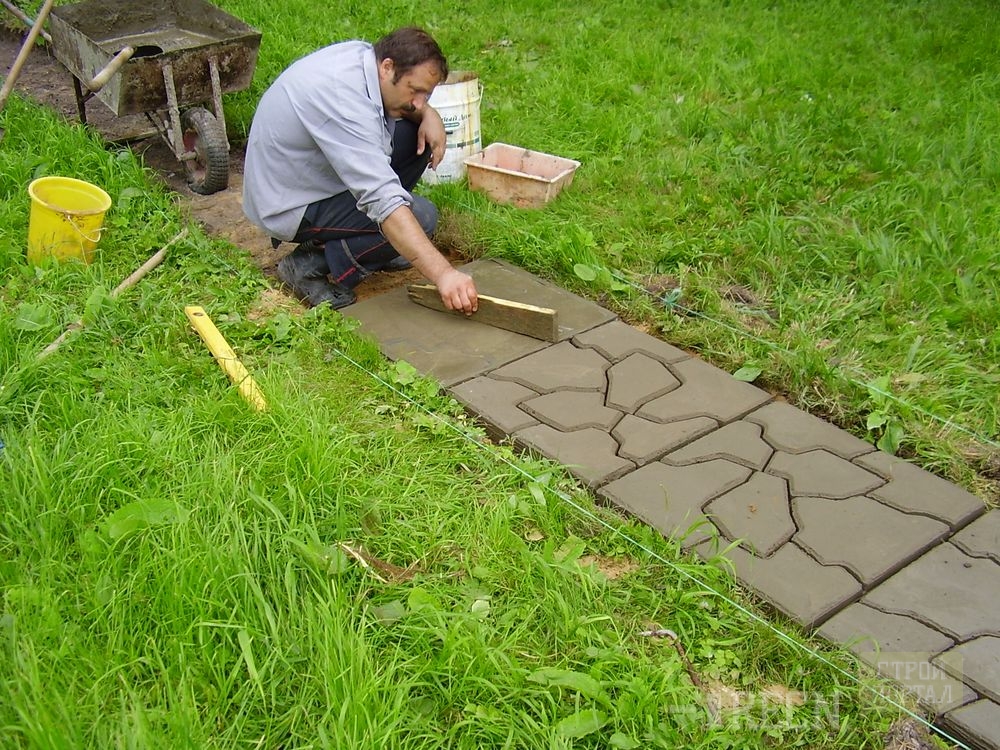
- The lubricated form is installed on wet sand and poured concrete.
- The grinder is distributed in shape, filling it to the edges.
- Surplus are removed with a wide spatula or any flat flat rack.
- If the solution is made correctly, so that it "grab" is enough for 10-20 minutes. After this time, you can neatly get the shape and shift it into the next place to continue.
- The presence of two or three stencils will speed up the construction.
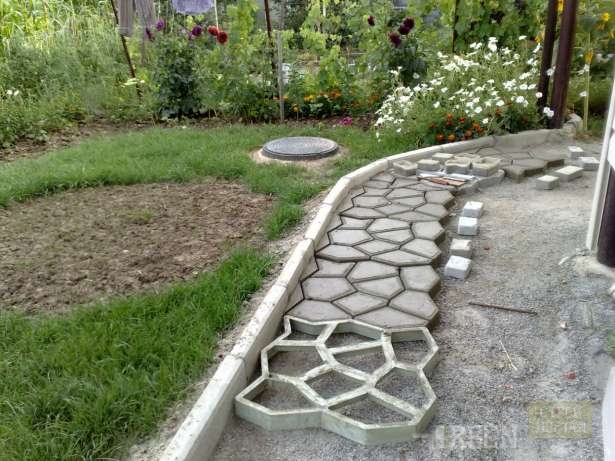
In order to diversify the concrete tracks of the photo of which on the Internet it is easy to find, the coloring pigment is added to the solution. In addition, they can be decorated with colored pebbles, shells, teldling fragments or other suitable materials. Decorative elements are pressed into the crude solution and after it is drying it is tight enough.
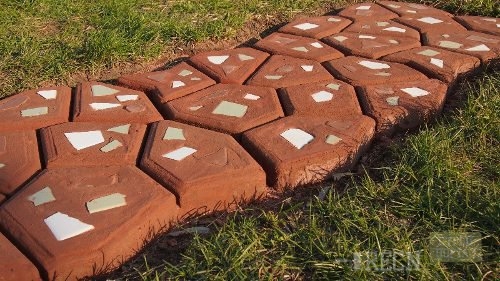
Completely hardens concrete for 3-4 days. During this time it is desirable to regularly water water and cover with film or tarpaulter. This is especially important in hot summer weather - the longer the concrete is frozen, the more stronger.
The slots between the tiles are filled with cement-sandy mixture and poured with water. It prevents ingestion of soil and germination of grass. But in some cases, the gaps are specially filled with soil with lawn grass seeds.
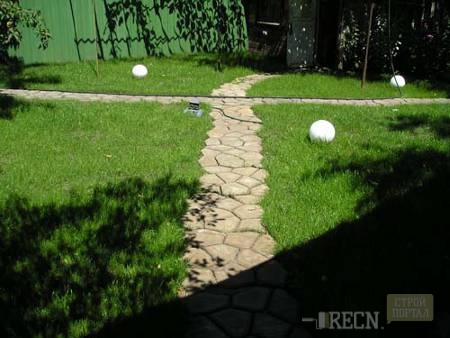
The main stages of the construction of a concrete track:
- circuit drawing;
- marking tracks;
- sampling of the soil, the rambling of the bottom of the trench;
- failure of rubble;
- laying geotextile;
- failure and trimming sand;
- preparation of the solution;
- filling forms concrete;
- failure of the seams of the CPS, sand or soil.
Each well-kept plot requires attention and labor. A little effort and its space will be decorated with original tracks - straight or winding, color or monophonic - it all depends on the desire and taste of the owner.


















